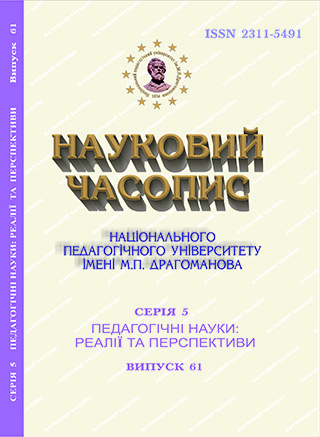THE IMPACT OF PERCEPTION STYLES ON THE CHOICE OF CLASSROOM ACTIVITIES IN ESL TEACHING
Ключові слова:
learning types, motivation, auditory, visual, kinesthetic, perceptual, teaching strategiesАнотація
Today educational research in the sphere of academic acquisition has outspread to psychological learning-related issues.Among the vast amount of those existing our attention fell onto learning style that impacts performance and learning outcomes.
In the present article the authors defined the perceptual learning styles among their students and described the most efficient
and productive teaching strategies to meet the needs and peculiarities of visuals. The article presents a research aiming to explore learning styles among the students of technical specialization studying English as a second language and quantitatively represents the results of the conducted study, considers choice of educational materials and teaching strategies. The participants were 60 students, who took part in a survey which included passing the short test to define the learning style. Findings of survey revealed that the vast number of participants favored visual perception style. The questionnaire showed that the most preferable activities for the visual learners are using graphs, presentations, vocabulary cards, video etc
Посилання
Arthurs, J. B. (2007). A juggling act in the classroom. Managing different learning styles. Teaching and Learning in Nursing,
, 2-7. Retrieved from: http://dx.doi.org/10.1016/j.teln.2006.10.002
Bell, J. (2007). Evaluation of learning styles and instructional methods in the NROTC Naval Operations and Seamanship Course.
Institute for Learning Style Journal, 1, 52-61.
Brown H. D. (2000). Principles of language teaching and learning (4th ed.). White Plains, NY: Longman.
Cassidy, S. (2004) Learning styles: An overview of theories, models, and measures. Educational Psychology, 24 (4), 419- 441.
Fleming ND, Mills C. (1992) Not Another Inventory, Rather a Catalyst for reflection. To Improve the Academy. 11:137–55.
Fleming, N. D. (2001). Teaching and learning styles: VARK strategies. Christchurch, New Zealand : N.D. Fleming.
Friedman V. (2008) “Data visualization and infographics” in: Graphics, Monday Inspiration. Retrieved from https://www.
smashingmagazine.com/2008/01/monday-inspiration-data-visualization-and-infographics/
Gibson, J. J. (1966). The Senses Considered as Perceptual Systems. Boston: Houghton Mifflin.
Gregory, R. (1970). The Intelligent Eye. London: Weidenfeld and Nicolson.
Hadfield J. (1999). Intermediate vocabulary games, Pearson Education limited, (pp.5) 146p.
Kudysheva A. A. (2010) Psychology of Teaching Foreign Languages Tutorial for students of philological specialties /
A. A. Kudysheva. – Pavlodar: Kerek. – 202 p.
Pesce Claudia. ESL learning styles. [electronic recourse]. Retrieved from: https://busyteacher.org/14192-how-to-teach-visuallearners-9-ways-esl-learning.html
Reid J. M. (1987). The learning style preferences of ESL students. TESOL Quarterly, 21 (1), 87-111.


